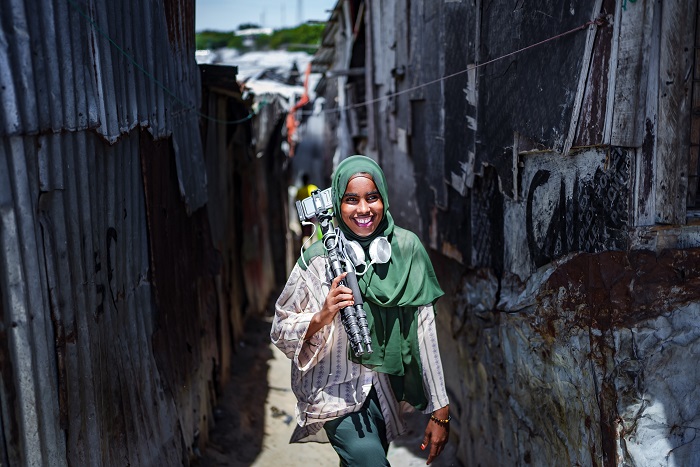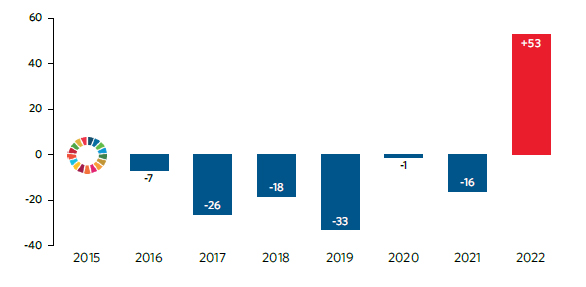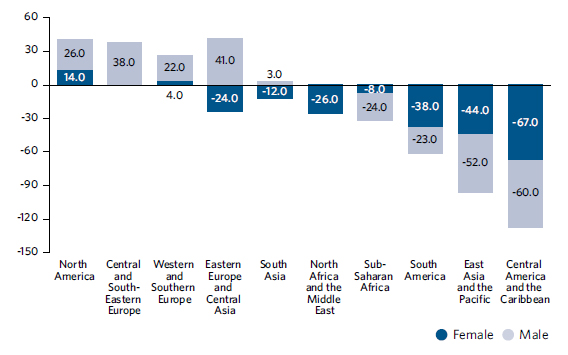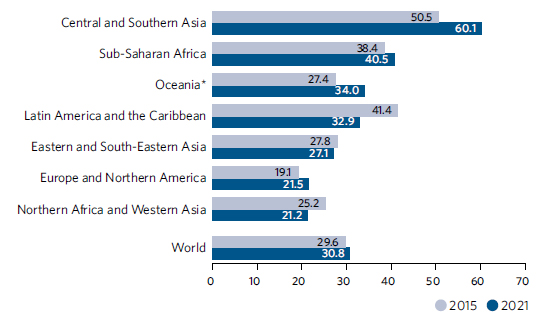Peace, justice and strong institutions

Shukri, the youngest member of Somalia’s first all-women media team, Bilan Media, films in Mogadishu amid the daily threat of targeted violence against journalists.
© UNDP Somalia/Fadhayerestore trust and to strengthen the capacity of institutions to secure justice for all and facilitate peaceful transitions to sustainable development.
Global homicides hit a 20-year high amid escalating gang and sociopolitical violence
Intentional homicides cause more deaths globally than conflict and terrorist killings combined. In 2021, there were approximately 458,000 intentional homicides – the highest number in the past two decades. The noticeable spike in killings in 2021 can be partly attributed to the economic repercussions of COVID-related restrictions, as well as an escalation of gang-related and sociopolitical violence in several countries. Taking the growing population into account, the homicide rate was 5.8 per 100,000 population in 2021, marginally lower than the 2015 rate of 5.9 per 100,000. Even assuming that 2021 has no bearing on future trends, projections based on 2015–2020 suggest that the homicide rate will have fallen by just 24 per cent by 2030 compared with 2015, far short of the target of halving 2015 levels.
In 2021, men and boys accounted for 81 per cent of all homicide victims globally, with a rate four times higher than that of women and girls. Regions with high overall levels of homicidal violence, such as Latin America and the Caribbean and sub-Saharan Africa, record higher shares of male homicide victims than other regions. Additionally, data from 101 countries reveal that more than 9 in 10 suspects of intentional homicides are men or boys.
Homicide rate, by victim’s sex, 2021 (deaths per 100,000 population)

There has been an unprecedented increase in civilian deaths in conflicts – the first since the adoption of the 2030 Agenda
Civilian deaths directly related to 12 of the world’s deadliest conflicts increased by 53 per cent between 2021 and 2022, marking the first rise since the adoption of the 2030 Agenda in 2015. At least 16,988 civilians were killed, with one in five victims being women. The use of heavy weapons and explosive munitions, including indiscriminate and disproportionate attacks, rose from 13 per cent in 2021 to 39 per cent in 2022, signaling a shift in conflict dynamics. Sub-Saharan Africa and Europe accounted for 90 per cent of the deaths, with 4 in 10 occurring specifically in Ukraine. While there was a 23 per cent increase in conflict-related casualties in sub-Saharan Africa, other parts of the world also saw increases in deadly incidents against civilians. These shocking figures demand a renewed global commitment to peace and security, with all parties involved in conflicts urged to abide by international humanitarian and human rights law to protect the lives of civilians, particularly those of children and women.
Change in documented conflict-related deaths of civilians, 2015–2022 (percentage)

Falling detection of victims of human trafficking during crises prompts new methods to track and combat this hidden crime
Trafficking in persons is a hidden crime. Available data capture only the number of detected victims, leaving many more unassisted and invisible to authorities. Between 2017 and 2020, data from 141 countries revealed 187,915 detected victims of trafficking. Moreover, in 2020, the number of victims of trafficking detected worldwide fell for the first time in 20 years, a decrease of 11 per cent from 2019. This decline can be attributed to the impact of COVID-19 preventive measures, which altered the dynamics of exploitation and compromised the anti-trafficking response. One emerging result is the 24 per cent drop in the detection of victims of trafficking for sexual exploitation between 2019 and 2020. This is the result of victims exploited in more concealed and dangerous locations. As more victims are likely remaining undetected, increasing efforts are needed to tailor the response to the real prevalence of the crime. Some Member States have shown promising results in testing and implementing new methodologies for prevalence estimates of trafficking in persons.
Change in the number of detected victims of trafficking in persons, by sex, per 100,000 population, comparison from 2019 to 2020 (percentage)

The global prison population keeps rising, creating overcrowding and concerns over the proportion of unsentenced detainees
Access to justice is a fundamental human right for which reducing the number of unsentenced detainees is crucial. After rising steadily from 2015 to 2019, the global prison population declined in 2020 due to COVID-19. Then in 2021, the number of prisoners returned to an upward trend, totalling 11.2 million, with about one-third (3.4 million) held in pre-trial detention. Central and Southern Asia has the highest percentage of unsentenced detainees (60 per cent), while Northern Africa and Western Asia have the lowest (21 per cent). While the overall share remained around 30 per cent from 2015 to 2021, Oceania saw an increase in the share of individuals awaiting trial or sentencing, and Latin America and the Caribbean saw a decrease.
Although prison capacity increased by 19 per cent from 2015 to 2021, overcrowding remains a challenge. Almost half of countries with relevant data (46 out of 96) reported operating at over 100 per cent of their intended capacity, and 18 per cent were functioning at over 150 per cent. Overcrowding adversely affects prisoner health and survival. The data suggest the need for countries to provide adequate space and resources for prisoners to promote rehabilitation, reduce recidivism, and ensure prisoner and societal well-being.
Unsentenced detainees as a proportion of overall prison population, 2015 and 2021 (percentage)

*Excluding Australia and New Zealand.
Drug trafficking is generating illicit financial flows worth billions, fuelling corruption and diverting resources
Illicit financial flows fuel corruption and divert criminal proceeds into legal and illegal economic activities. Drug trafficking is a major source of inward and outward illicit financial flows, particularly in countries affected by cross-border drug flows. Recent estimates reveal that Mexican drug cartels alone generated average inward illicit financial flows of $12.1 billion annually between 2015 and 2018, comparable to the value of the country’s agricultural exports. Afghanistan, Colombia, Myanmar and Peru also experienced billions of dollars of illicit financial flows from cocaine and opiates trafficking. Opiates trafficking in Asia creates spillover effects, leading to outward illicit financial flows in neighbouring countries. Measuring the value of these illicit financial flows is vital to understanding the motivations behind illegal activities and to developing effective policies to combat them.
The number of young parliamentarians remains low, with few holding leadership positions
In every region of the world except Europe, people under the age of 45 are significantly underrepresented in parliament, relative to their share of national populations. Although the average eligible age to serve in parliament is 23 years, the proportion of members of parliament (MPs) aged 30 and under has remained at about 2–2.6 per cent for the past five years. While the global median age is just over 30 years, the average age of an MP is 51 years. Young MPs hold limited leadership positions, with less than 9 per cent serving as speaker and 17.4 per cent as committee chairs. To increase the participation of younger parliamentarians, efforts must include introducing quotas or lowering the age of eligibility.

